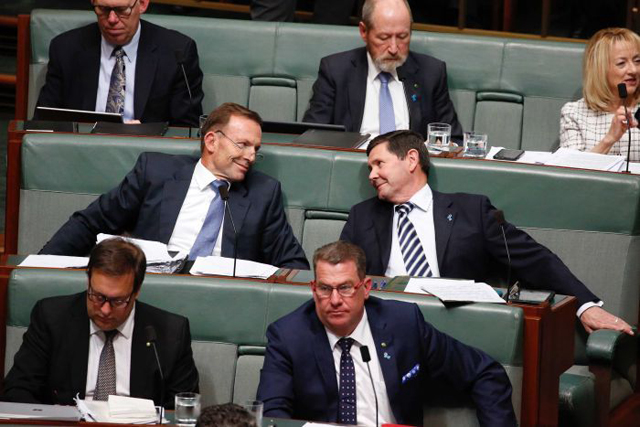In the face of unfolding calamity, politicians continue to play games with coal power.

Tony Abbott shares a moment with Kevin Andrews. PHOTO ABC
Every so often I reach a personal tipping point. It happens when I encounter one too many of those blithe ministerial statements on another motorway extension, or think-tank arguments for more corporate freedom, or company proposals for yet another extractive venture.
At times like these I dip into the sobering world of people like Andrew Glikson. You could say Glikson is an Australian version of James Hansen, who has been warning US politicians since the 1980s that they ignore emissions from burning oil and coal at everyone’s peril.
Except that Glikson, a senior earth and climate scientist at the Australian National University, is very much his own person, on a professional and personal quest to investigate Earth’s climate and alert people – students, politicians and anyone else prepared to listen – of its parlous state.
Tipping points on a planetary scale concern Glikson a lot. In 2015 he warned the level of carbon in the atmosphere was rising at an unprecedented rate. The increase of 3.05 parts per million in 2015 was over three times the increase in 1959 and faster than any observed in the geological record.
The rapid accumulation of atmospheric carbon is driving an equally rapid increase in global warming. Scientists accused of being “warmist”, says Glikson, feel obliged to underestimate the consequences of this, because “many cannot bring themselves to look at the unthinkable”.
He says their caution – Hansen called it “dangerous scientific reticence”– has led the Intergovernmental Panel on Climate Change to repeatedly underestimate rates of future continental ice sheet melting, permafrost melting, methane release, sea level rises and wildfire occurrence.
Rising emissions pushing the temperature up 1.2C (1.5C over the continents) since 1880 have put us in uncharted territory. Glikson warns that past climates have shown that once a temperature threshold is breached, amplifying feedbacks can trigger sudden, devastating events.
Last February, normally the Arctic’s coldest time of the year, temperatures reached about 20°C above average. Northern Greenland saw its yearly average of hours above freezing more than trebled within a few days. And sea ice began to shrink at a time when it should be growing.
Glikson has identified many Arctic tipping points, including a rapidly warming, increasingly ice-free Arctic Ocean; a fast-rising rate of methane release from Arctic permafrost; and accelerated melting of Greenland’s ice-sheet creating a pool of cold Atlantic surface water. That in turn cools Europe and North America, opening a door for icy blasts like the recent “beast from the east”.
The global reinsurance giant Munich Re has another indicator. It reports that over decades up to the early 1980s, extreme events (the insurance industry calls them “loss events”, for obvious reasons) were typically below 400 per year globally. Since 2015 they have topped 1000 a year.
Things seem to be reaching some sort of crescendo in the United States. Its disaster relief spending just for last year – a total of $306.2 billion – was about the same as the country had previously spent over three decades, from 1980 to 2010 (CPI-adjusted).
While the incidence of fire and flood in Australia is apparently on the rise and wildfire seasons are lengthening, signals here are not quite as clear-cut – until you take a look at our coastal seas.
Warming waters are putting the Great Barrier Reef under threat as never before. South-eastern Australian and especially Tasmanian waters are already near or at crisis point. Aquaculture losses are bad; loss of vast areas of coastal kelp forest to invading warm-water species is much worse.
Glikson, Hansen and many other eminent scientists around the world have been warning for decades of the reality of dangerous climate change. Peer-reviewed studies have consistently found that above 95 per cent of practising climate scientists share their concerns.
Confronted by overwhelming evidence of unfolding calamity, last month Glikson lamented the “wilful ignorance” of powerful political figures “in promoting carbon emissions and allowing the devastation of large parts of the habitable biosphere”.
Among federal politicians this month, wilful ignorance has turned into high farce. A new conservative faction has emerged calling itself the “Monash Forum” on the presumption that World War I hero John Monash would today have supported a new public-funded coal power plant.
Aside from the absurd claim about Monash – supporting brown coal power as he did in the 1920s is a world away from doing the same 100 years later – this is also a slap-down of science’s finding that greenhouse pollution is a clear and present danger to life on Earth.
Tony Abbott, Eric Abetz, Kevin Andrews, Barnaby Joyce, George Christensen, Craig Kelly and other MPs have determined that they, with no scientific training, know better than those who have dedicated their lives to understanding planetary processes.
They are like little boys playing games with deadly weapons. We need that like a hole in the head.
